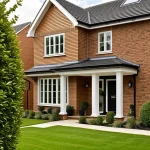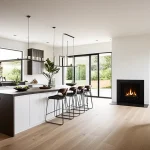The Influence of Interior Design on Well-being in UK Homes
Exploring how spaces shape our health and happiness
Interior design trends UK demonstrate a growing awareness of the home environment impact on well-being at home. The choice of colours, layouts, and materials isn’t just aesthetic—it’s deeply tied to both mental and physical health. For instance, cramped or poorly lit spaces can increase stress, while thoughtfully designed interiors often foster calm and relaxation.
Also to read : Is Green Real Estate the Key to Future Investments in the UK?
In UK homes, factors like the often unpredictable weather and limited natural daylight amplify the importance of design. Maximising light through window placement or reflective surfaces isn’t merely stylish; it supports circadian rhythms, improving sleep and mood. Moreover, cultural preferences for cosy, inviting settings influence design trends UK, encouraging the use of warm textures and familiar layouts to build comfort.
Well-being at home is not just about avoiding discomfort; it’s about creating positive emotional experiences daily. Interior design trends UK incorporate these principles by blending functionality with sensory appeal. This approach acknowledges that a well-considered home environment can elevate quality of life, especially in climates that pose challenges like the UK’s colder months and variable daylight.
Also to read : How Will UK Real Estate Fare Against Emerging Financial Regulations?
The Influence of Interior Design on Well-being in UK Homes
Small yet significant ways spaces shape our daily lives
Interior design trends UK highlight a clear link between the home environment impact and overall well-being at home. Thoughtful choices in layout, colour, and materials do more than create beauty—they actively support mental and physical health. For example, selecting calming colour palettes based on colour psychology can reduce anxiety and elevate mood, showing how design directly influences our feelings.
In the UK, where weather often limits time outdoors, incorporating natural materials and maximizing natural light becomes crucial. Natural materials like wood and stone not only bring tactile warmth but enhance air quality and connect residents to nature—a core principle of biophilic design. The resulting spaces feel more restorative and grounded, promoting relaxation and better sleep.
Moreover, well-being at home depends heavily on creating environments that reduce stress. Decluttered, minimalist layouts allow easier movement and mental clarity, supporting emotional stability. UK cultural preferences also play a role: familiar textures and cosy elements nurture a sense of security in often chilly homes.
Combined, these interior design trends UK reflect a sophisticated understanding that spaces must nurture both body and mind to truly enhance well-being at home.
The Influence of Interior Design on Well-being in UK Homes
Space, culture, and climate shaping our daily health
The link between interior design trends UK and well-being at home is becoming increasingly clear. Design choices are vital not only for aesthetics but for their profound home environment impact on physical and mental health. For instance, selecting calming or uplifting colours according to colour psychology can markedly influence mood and reduce anxiety.
In the UK, variable weather and often limited natural light mean adapting interiors to enhance light quality and warmth is crucial for residents’ health. This is more than style—it’s about reinforcing circadian rhythms and emotional stability. Using natural materials like wood or stone reflects deep cultural preferences and supports indoor air quality, contributing to wellbeing.
The typical UK home benefits from layouts that promote ease and decluttered spaces. These reduce mental overload, encourage relaxation, and help counteract stresses linked to smaller or older properties common in the region.
Ultimately, the best interior design trends UK integrate these factors—climate, cultural needs, psychological wellbeing—creating homes that nurture body and mind while respecting local conditions. Such thoughtful environments confirm that wellness starts where we live.
The Influence of Interior Design on Well-being in UK Homes
A careful blend of culture, climate, and design choices
The home environment impact in the UK is shaped strongly by interior design trends UK adapted to local conditions. Because many UK homes face limited natural light due to climate and building structures, design choices become essential to support well-being at home. Using light-enhancing colours, reflective surfaces, and strategic layouts helps brighten interiors, which aligns with maintaining circadian rhythms crucial for mental and physical health.
Moreover, cultural preferences within the UK favour warmth and comfort, influencing material selections. Natural materials such as wood and wool are not only tactilely comforting but promote a sense of familiarity and security, which supports emotional well-being. These design choices reflect an understanding of both psychological and physical needs in domestic spaces.
Studies show that well-considered interior design trends UK strongly affect day-to-day mood and stress levels. Clutter-free, functional spaces enable easier movement and mental clarity, which is vital in often smaller UK homes. Ultimately, these design elements craft environments that cater explicitly to the UK’s unique climate and cultural tastes, enhancing residents’ overall wellness sustainably.
The Influence of Interior Design on Well-being in UK Homes
Sculpting healthier lives through thoughtful home environments
The home environment impact in the UK cannot be overstated, with interior design trends UK playing a pivotal role in enhancing well-being at home. Given the UK’s unique climate and cultural fabric, design choices go beyond aesthetics to directly affect residents’ mental and physical health.
Colour psychology is a powerful tool within these trends, where calming hues such as soft blues and greens actively lower anxiety and elevate mood. This aligns with the broader aim of well-being at home by tailoring spaces to soothe occupants emotionally. Coupled with this, natural materials—like sustainably sourced wood and wool—introduce tactile warmth and foster a connection to nature, reinforcing psychological comfort within indoor settings.
Moreover, maximizing natural light through architectural layout and reflective surfaces addresses the UK’s limited daylight. This design strategy supports circadian rhythms, which are essential for restful sleep and emotional stability. Together, these elements reveal a sophisticated understanding that interior design trends UK are not merely decorative but integrative solutions to environmental and cultural challenges.
In sum, the UK’s distinctive needs shape a home environment impact that balances traditional warmth with contemporary health-centric design, creating living spaces that actively nurture both body and mind.
The Influence of Interior Design on Well-being in UK Homes
A detailed look at design’s vital role in mental and physical health
The connection between interior design trends UK and well-being at home is deeply rooted in how spaces shape bodily and emotional experiences. Design choices influence mental health by affecting stress, mood, and cognition through elements such as layout, colour, and materials. For example, cramped or cluttered environments elevate stress and anxiety, while open, airy spaces encourage relaxation and mental clarity, illustrating the profound home environment impact.
Physical health benefits also stem from design. Good air quality, natural light, and ergonomic layouts reduce physical discomfort and support restorative sleep and energy levels. Especially in UK homes, where the climate limits outdoor time, interior design compensates for environmental factors by enhancing light exposure and warmth, directly improving residents’ health.
Cultural aspects in the UK add dimension to this relationship. The preference for cosy, familiar interiors reflects a collective need for security and comfort, vital for emotional well-being. By blending these cultural values with practical climate adaptations, interior design trends UK create spaces that nurture both mind and body.
Overall, understanding this relationship equips homeowners and designers to prioritise elements that promote holistic health, making well-being an achievable goal through considered design decisions.





